Organisational Culture, Politics, Power, Motivation and Teams Report
VerifiedAdded on 2023/02/03
|20
|4784
|52
Report
AI Summary
This report analyzes organisational behaviour within the context of AM Holding Limited, a packaging and container company. It explores the influence of organisational culture, politics, and power dynamics on employee behaviour and performance. The report delves into different types of organisational culture, power structures (legitimate, coercive, reward, and referent), and the impact of politics on the workplace. Furthermore, it examines content (Maslow's hierarchy, Hertzberg) and process theories (Vroom) of motivation, providing insights into how to enhance employee efficiency and productivity. The report also contrasts effective and ineffective team characteristics and concludes with a discussion of the concepts and philosophies of organisational behaviour in relation to the selected organisation.
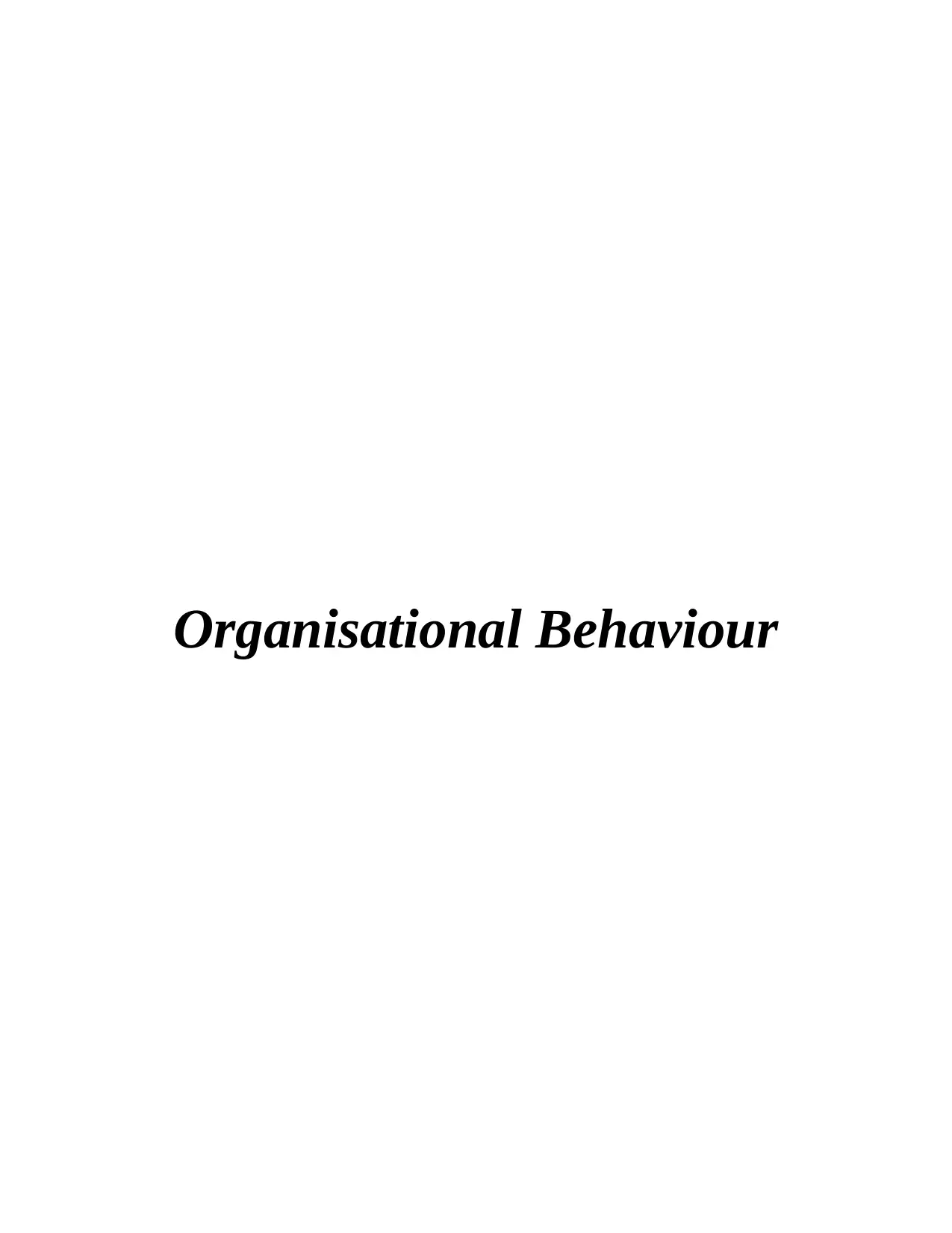
Organisational Behaviour
Paraphrase This Document
Need a fresh take? Get an instant paraphrase of this document with our AI Paraphraser
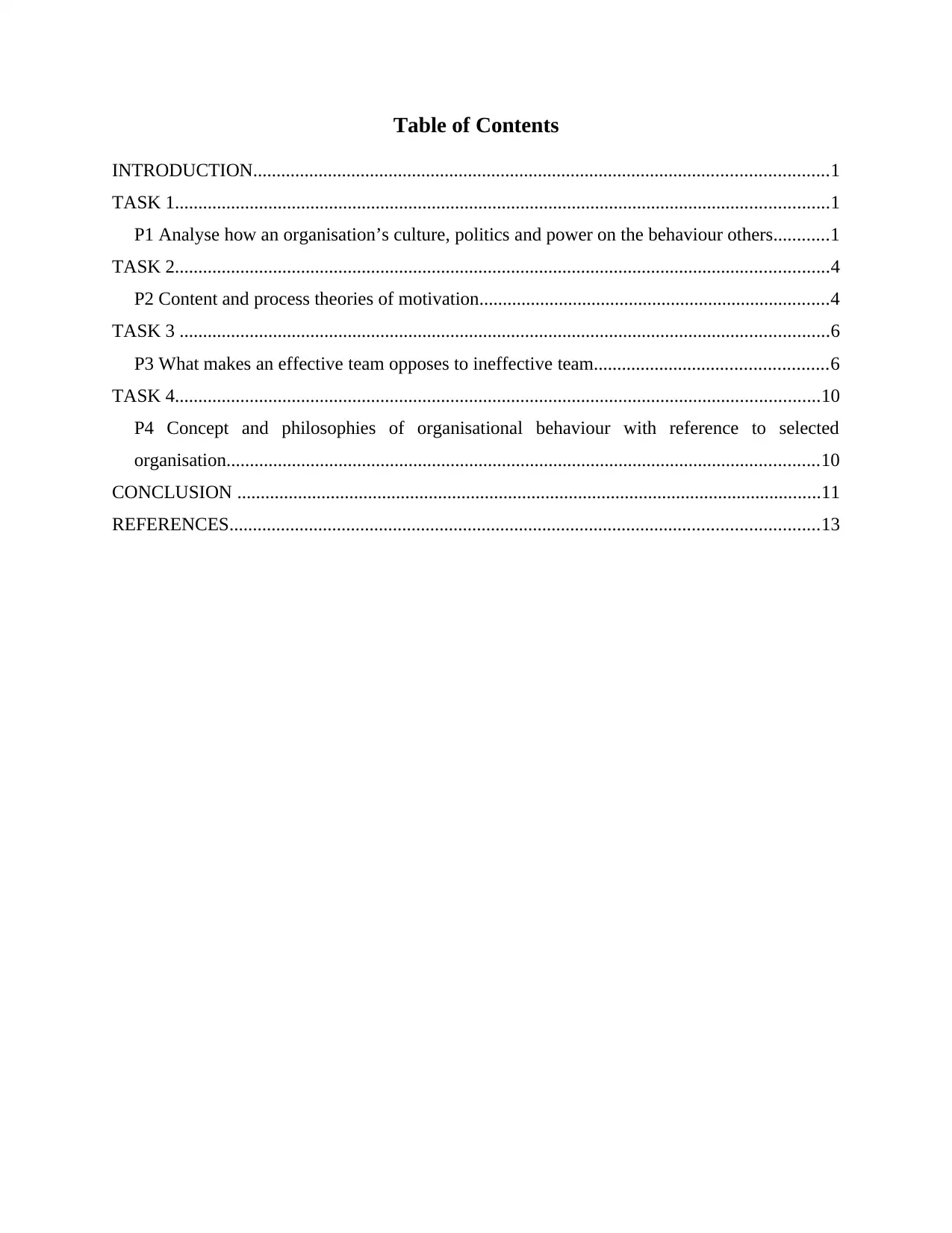
Table of Contents
INTRODUCTION...........................................................................................................................1
TASK 1............................................................................................................................................1
P1 Analyse how an organisation’s culture, politics and power on the behaviour others............1
TASK 2............................................................................................................................................4
P2 Content and process theories of motivation...........................................................................4
TASK 3 ...........................................................................................................................................6
P3 What makes an effective team opposes to ineffective team..................................................6
TASK 4..........................................................................................................................................10
P4 Concept and philosophies of organisational behaviour with reference to selected
organisation...............................................................................................................................10
CONCLUSION .............................................................................................................................11
REFERENCES..............................................................................................................................13
INTRODUCTION...........................................................................................................................1
TASK 1............................................................................................................................................1
P1 Analyse how an organisation’s culture, politics and power on the behaviour others............1
TASK 2............................................................................................................................................4
P2 Content and process theories of motivation...........................................................................4
TASK 3 ...........................................................................................................................................6
P3 What makes an effective team opposes to ineffective team..................................................6
TASK 4..........................................................................................................................................10
P4 Concept and philosophies of organisational behaviour with reference to selected
organisation...............................................................................................................................10
CONCLUSION .............................................................................................................................11
REFERENCES..............................................................................................................................13
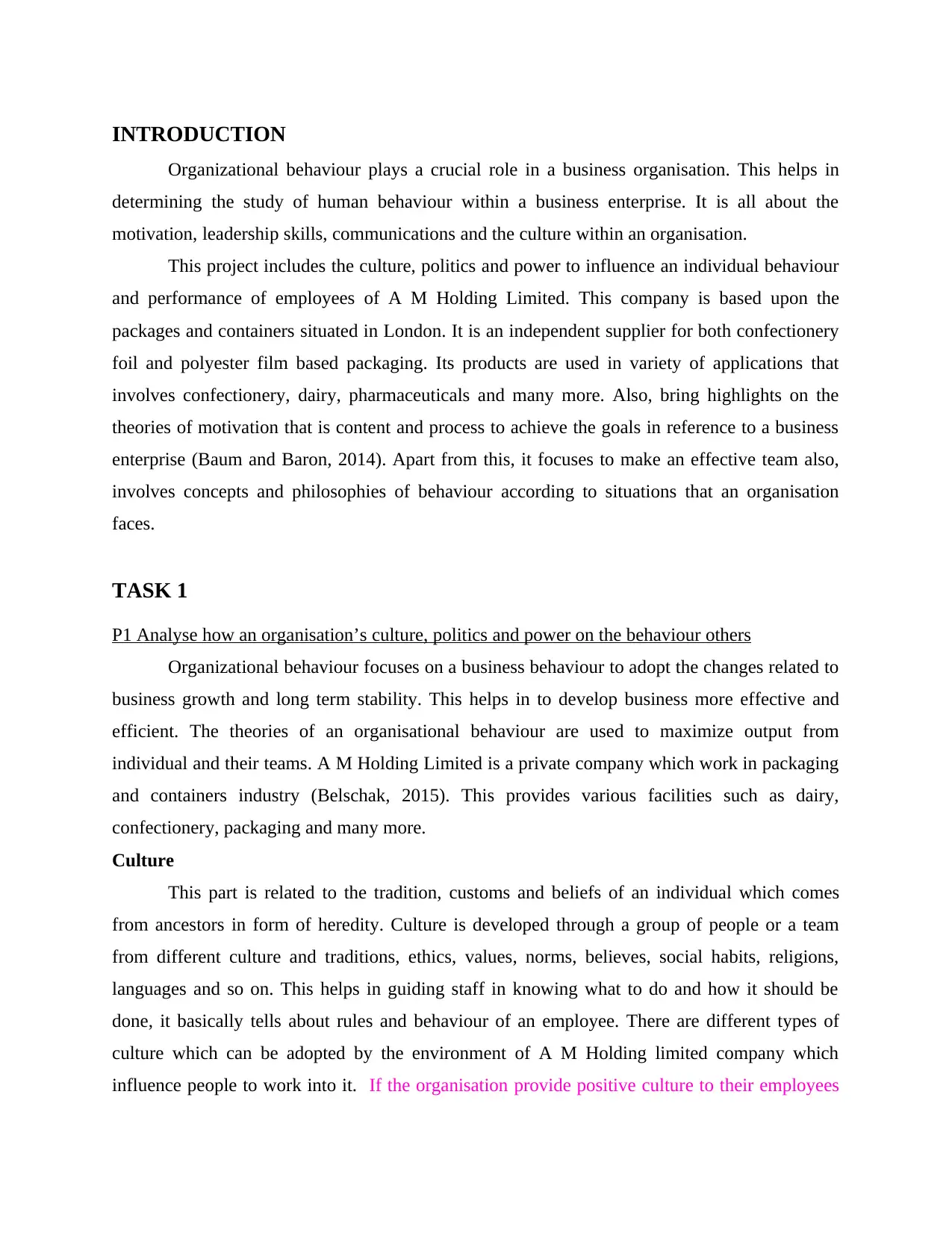
INTRODUCTION
Organizational behaviour plays a crucial role in a business organisation. This helps in
determining the study of human behaviour within a business enterprise. It is all about the
motivation, leadership skills, communications and the culture within an organisation.
This project includes the culture, politics and power to influence an individual behaviour
and performance of employees of A M Holding Limited. This company is based upon the
packages and containers situated in London. It is an independent supplier for both confectionery
foil and polyester film based packaging. Its products are used in variety of applications that
involves confectionery, dairy, pharmaceuticals and many more. Also, bring highlights on the
theories of motivation that is content and process to achieve the goals in reference to a business
enterprise (Baum and Baron, 2014). Apart from this, it focuses to make an effective team also,
involves concepts and philosophies of behaviour according to situations that an organisation
faces.
TASK 1
P1 Analyse how an organisation’s culture, politics and power on the behaviour others
Organizational behaviour focuses on a business behaviour to adopt the changes related to
business growth and long term stability. This helps in to develop business more effective and
efficient. The theories of an organisational behaviour are used to maximize output from
individual and their teams. A M Holding Limited is a private company which work in packaging
and containers industry (Belschak, 2015). This provides various facilities such as dairy,
confectionery, packaging and many more.
Culture
This part is related to the tradition, customs and beliefs of an individual which comes
from ancestors in form of heredity. Culture is developed through a group of people or a team
from different culture and traditions, ethics, values, norms, believes, social habits, religions,
languages and so on. This helps in guiding staff in knowing what to do and how it should be
done, it basically tells about rules and behaviour of an employee. There are different types of
culture which can be adopted by the environment of A M Holding limited company which
influence people to work into it. If the organisation provide positive culture to their employees
Organizational behaviour plays a crucial role in a business organisation. This helps in
determining the study of human behaviour within a business enterprise. It is all about the
motivation, leadership skills, communications and the culture within an organisation.
This project includes the culture, politics and power to influence an individual behaviour
and performance of employees of A M Holding Limited. This company is based upon the
packages and containers situated in London. It is an independent supplier for both confectionery
foil and polyester film based packaging. Its products are used in variety of applications that
involves confectionery, dairy, pharmaceuticals and many more. Also, bring highlights on the
theories of motivation that is content and process to achieve the goals in reference to a business
enterprise (Baum and Baron, 2014). Apart from this, it focuses to make an effective team also,
involves concepts and philosophies of behaviour according to situations that an organisation
faces.
TASK 1
P1 Analyse how an organisation’s culture, politics and power on the behaviour others
Organizational behaviour focuses on a business behaviour to adopt the changes related to
business growth and long term stability. This helps in to develop business more effective and
efficient. The theories of an organisational behaviour are used to maximize output from
individual and their teams. A M Holding Limited is a private company which work in packaging
and containers industry (Belschak, 2015). This provides various facilities such as dairy,
confectionery, packaging and many more.
Culture
This part is related to the tradition, customs and beliefs of an individual which comes
from ancestors in form of heredity. Culture is developed through a group of people or a team
from different culture and traditions, ethics, values, norms, believes, social habits, religions,
languages and so on. This helps in guiding staff in knowing what to do and how it should be
done, it basically tells about rules and behaviour of an employee. There are different types of
culture which can be adopted by the environment of A M Holding limited company which
influence people to work into it. If the organisation provide positive culture to their employees
⊘ This is a preview!⊘
Do you want full access?
Subscribe today to unlock all pages.

Trusted by 1+ million students worldwide
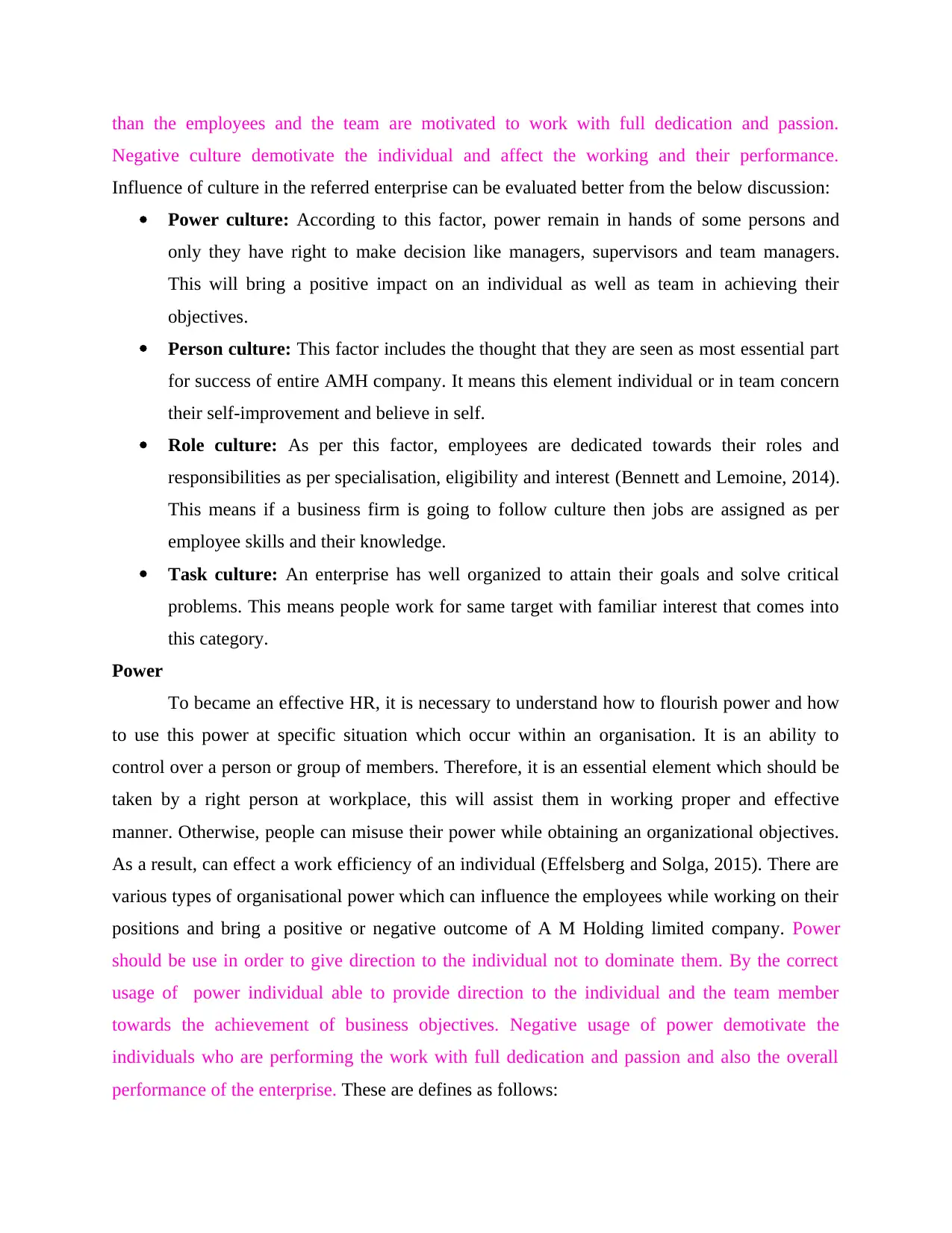
than the employees and the team are motivated to work with full dedication and passion.
Negative culture demotivate the individual and affect the working and their performance.
Influence of culture in the referred enterprise can be evaluated better from the below discussion:
Power culture: According to this factor, power remain in hands of some persons and
only they have right to make decision like managers, supervisors and team managers.
This will bring a positive impact on an individual as well as team in achieving their
objectives.
Person culture: This factor includes the thought that they are seen as most essential part
for success of entire AMH company. It means this element individual or in team concern
their self-improvement and believe in self.
Role culture: As per this factor, employees are dedicated towards their roles and
responsibilities as per specialisation, eligibility and interest (Bennett and Lemoine, 2014).
This means if a business firm is going to follow culture then jobs are assigned as per
employee skills and their knowledge.
Task culture: An enterprise has well organized to attain their goals and solve critical
problems. This means people work for same target with familiar interest that comes into
this category.
Power
To became an effective HR, it is necessary to understand how to flourish power and how
to use this power at specific situation which occur within an organisation. It is an ability to
control over a person or group of members. Therefore, it is an essential element which should be
taken by a right person at workplace, this will assist them in working proper and effective
manner. Otherwise, people can misuse their power while obtaining an organizational objectives.
As a result, can effect a work efficiency of an individual (Effelsberg and Solga, 2015). There are
various types of organisational power which can influence the employees while working on their
positions and bring a positive or negative outcome of A M Holding limited company. Power
should be use in order to give direction to the individual not to dominate them. By the correct
usage of power individual able to provide direction to the individual and the team member
towards the achievement of business objectives. Negative usage of power demotivate the
individuals who are performing the work with full dedication and passion and also the overall
performance of the enterprise. These are defines as follows:
Negative culture demotivate the individual and affect the working and their performance.
Influence of culture in the referred enterprise can be evaluated better from the below discussion:
Power culture: According to this factor, power remain in hands of some persons and
only they have right to make decision like managers, supervisors and team managers.
This will bring a positive impact on an individual as well as team in achieving their
objectives.
Person culture: This factor includes the thought that they are seen as most essential part
for success of entire AMH company. It means this element individual or in team concern
their self-improvement and believe in self.
Role culture: As per this factor, employees are dedicated towards their roles and
responsibilities as per specialisation, eligibility and interest (Bennett and Lemoine, 2014).
This means if a business firm is going to follow culture then jobs are assigned as per
employee skills and their knowledge.
Task culture: An enterprise has well organized to attain their goals and solve critical
problems. This means people work for same target with familiar interest that comes into
this category.
Power
To became an effective HR, it is necessary to understand how to flourish power and how
to use this power at specific situation which occur within an organisation. It is an ability to
control over a person or group of members. Therefore, it is an essential element which should be
taken by a right person at workplace, this will assist them in working proper and effective
manner. Otherwise, people can misuse their power while obtaining an organizational objectives.
As a result, can effect a work efficiency of an individual (Effelsberg and Solga, 2015). There are
various types of organisational power which can influence the employees while working on their
positions and bring a positive or negative outcome of A M Holding limited company. Power
should be use in order to give direction to the individual not to dominate them. By the correct
usage of power individual able to provide direction to the individual and the team member
towards the achievement of business objectives. Negative usage of power demotivate the
individuals who are performing the work with full dedication and passion and also the overall
performance of the enterprise. These are defines as follows:
Paraphrase This Document
Need a fresh take? Get an instant paraphrase of this document with our AI Paraphraser
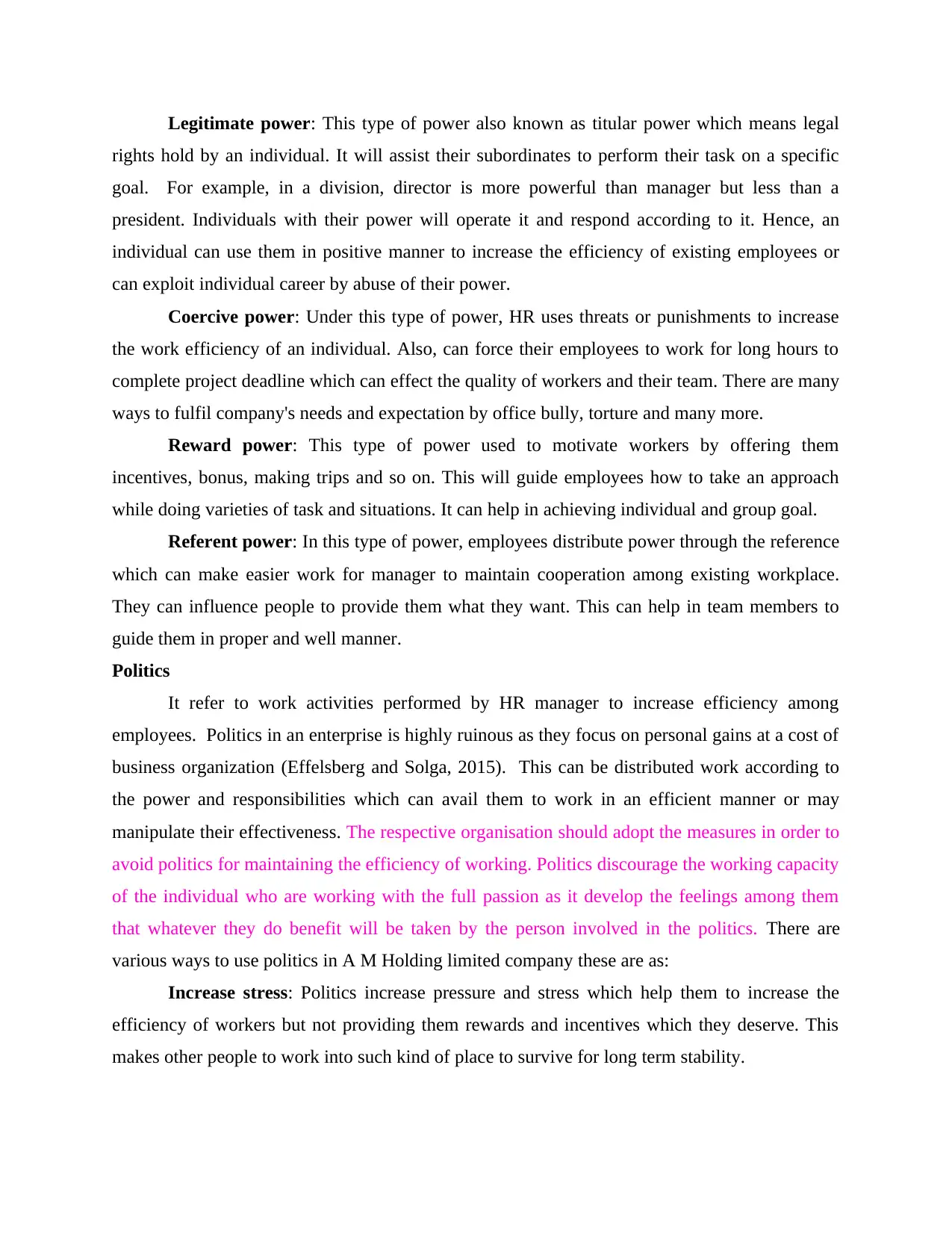
Legitimate power: This type of power also known as titular power which means legal
rights hold by an individual. It will assist their subordinates to perform their task on a specific
goal. For example, in a division, director is more powerful than manager but less than a
president. Individuals with their power will operate it and respond according to it. Hence, an
individual can use them in positive manner to increase the efficiency of existing employees or
can exploit individual career by abuse of their power.
Coercive power: Under this type of power, HR uses threats or punishments to increase
the work efficiency of an individual. Also, can force their employees to work for long hours to
complete project deadline which can effect the quality of workers and their team. There are many
ways to fulfil company's needs and expectation by office bully, torture and many more.
Reward power: This type of power used to motivate workers by offering them
incentives, bonus, making trips and so on. This will guide employees how to take an approach
while doing varieties of task and situations. It can help in achieving individual and group goal.
Referent power: In this type of power, employees distribute power through the reference
which can make easier work for manager to maintain cooperation among existing workplace.
They can influence people to provide them what they want. This can help in team members to
guide them in proper and well manner.
Politics
It refer to work activities performed by HR manager to increase efficiency among
employees. Politics in an enterprise is highly ruinous as they focus on personal gains at a cost of
business organization (Effelsberg and Solga, 2015). This can be distributed work according to
the power and responsibilities which can avail them to work in an efficient manner or may
manipulate their effectiveness. The respective organisation should adopt the measures in order to
avoid politics for maintaining the efficiency of working. Politics discourage the working capacity
of the individual who are working with the full passion as it develop the feelings among them
that whatever they do benefit will be taken by the person involved in the politics. There are
various ways to use politics in A M Holding limited company these are as:
Increase stress: Politics increase pressure and stress which help them to increase the
efficiency of workers but not providing them rewards and incentives which they deserve. This
makes other people to work into such kind of place to survive for long term stability.
rights hold by an individual. It will assist their subordinates to perform their task on a specific
goal. For example, in a division, director is more powerful than manager but less than a
president. Individuals with their power will operate it and respond according to it. Hence, an
individual can use them in positive manner to increase the efficiency of existing employees or
can exploit individual career by abuse of their power.
Coercive power: Under this type of power, HR uses threats or punishments to increase
the work efficiency of an individual. Also, can force their employees to work for long hours to
complete project deadline which can effect the quality of workers and their team. There are many
ways to fulfil company's needs and expectation by office bully, torture and many more.
Reward power: This type of power used to motivate workers by offering them
incentives, bonus, making trips and so on. This will guide employees how to take an approach
while doing varieties of task and situations. It can help in achieving individual and group goal.
Referent power: In this type of power, employees distribute power through the reference
which can make easier work for manager to maintain cooperation among existing workplace.
They can influence people to provide them what they want. This can help in team members to
guide them in proper and well manner.
Politics
It refer to work activities performed by HR manager to increase efficiency among
employees. Politics in an enterprise is highly ruinous as they focus on personal gains at a cost of
business organization (Effelsberg and Solga, 2015). This can be distributed work according to
the power and responsibilities which can avail them to work in an efficient manner or may
manipulate their effectiveness. The respective organisation should adopt the measures in order to
avoid politics for maintaining the efficiency of working. Politics discourage the working capacity
of the individual who are working with the full passion as it develop the feelings among them
that whatever they do benefit will be taken by the person involved in the politics. There are
various ways to use politics in A M Holding limited company these are as:
Increase stress: Politics increase pressure and stress which help them to increase the
efficiency of workers but not providing them rewards and incentives which they deserve. This
makes other people to work into such kind of place to survive for long term stability.
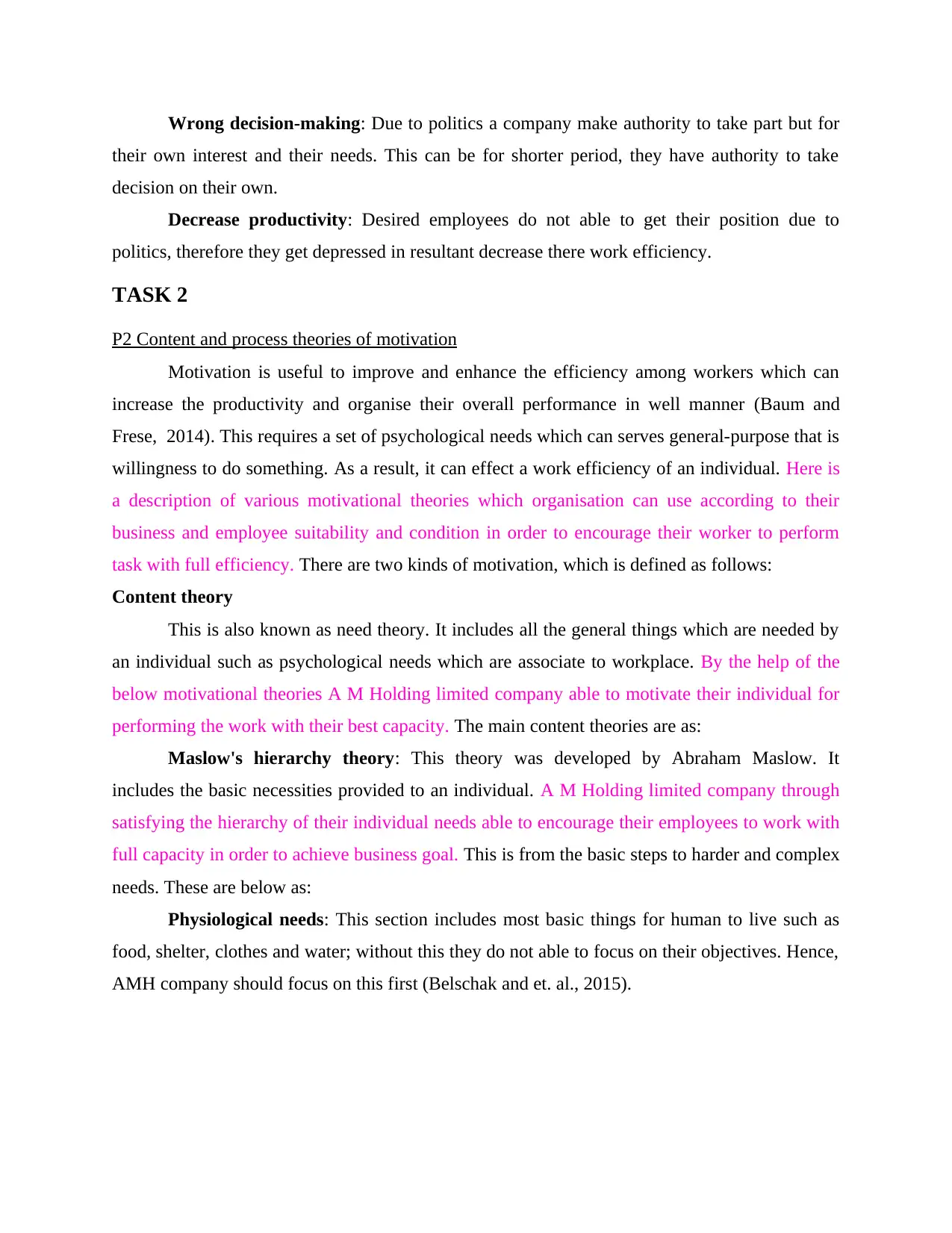
Wrong decision-making: Due to politics a company make authority to take part but for
their own interest and their needs. This can be for shorter period, they have authority to take
decision on their own.
Decrease productivity: Desired employees do not able to get their position due to
politics, therefore they get depressed in resultant decrease there work efficiency.
TASK 2
P2 Content and process theories of motivation
Motivation is useful to improve and enhance the efficiency among workers which can
increase the productivity and organise their overall performance in well manner (Baum and
Frese, 2014). This requires a set of psychological needs which can serves general-purpose that is
willingness to do something. As a result, it can effect a work efficiency of an individual. Here is
a description of various motivational theories which organisation can use according to their
business and employee suitability and condition in order to encourage their worker to perform
task with full efficiency. There are two kinds of motivation, which is defined as follows:
Content theory
This is also known as need theory. It includes all the general things which are needed by
an individual such as psychological needs which are associate to workplace. By the help of the
below motivational theories A M Holding limited company able to motivate their individual for
performing the work with their best capacity. The main content theories are as:
Maslow's hierarchy theory: This theory was developed by Abraham Maslow. It
includes the basic necessities provided to an individual. A M Holding limited company through
satisfying the hierarchy of their individual needs able to encourage their employees to work with
full capacity in order to achieve business goal. This is from the basic steps to harder and complex
needs. These are below as:
Physiological needs: This section includes most basic things for human to live such as
food, shelter, clothes and water; without this they do not able to focus on their objectives. Hence,
AMH company should focus on this first (Belschak and et. al., 2015).
their own interest and their needs. This can be for shorter period, they have authority to take
decision on their own.
Decrease productivity: Desired employees do not able to get their position due to
politics, therefore they get depressed in resultant decrease there work efficiency.
TASK 2
P2 Content and process theories of motivation
Motivation is useful to improve and enhance the efficiency among workers which can
increase the productivity and organise their overall performance in well manner (Baum and
Frese, 2014). This requires a set of psychological needs which can serves general-purpose that is
willingness to do something. As a result, it can effect a work efficiency of an individual. Here is
a description of various motivational theories which organisation can use according to their
business and employee suitability and condition in order to encourage their worker to perform
task with full efficiency. There are two kinds of motivation, which is defined as follows:
Content theory
This is also known as need theory. It includes all the general things which are needed by
an individual such as psychological needs which are associate to workplace. By the help of the
below motivational theories A M Holding limited company able to motivate their individual for
performing the work with their best capacity. The main content theories are as:
Maslow's hierarchy theory: This theory was developed by Abraham Maslow. It
includes the basic necessities provided to an individual. A M Holding limited company through
satisfying the hierarchy of their individual needs able to encourage their employees to work with
full capacity in order to achieve business goal. This is from the basic steps to harder and complex
needs. These are below as:
Physiological needs: This section includes most basic things for human to live such as
food, shelter, clothes and water; without this they do not able to focus on their objectives. Hence,
AMH company should focus on this first (Belschak and et. al., 2015).
⊘ This is a preview!⊘
Do you want full access?
Subscribe today to unlock all pages.

Trusted by 1+ million students worldwide
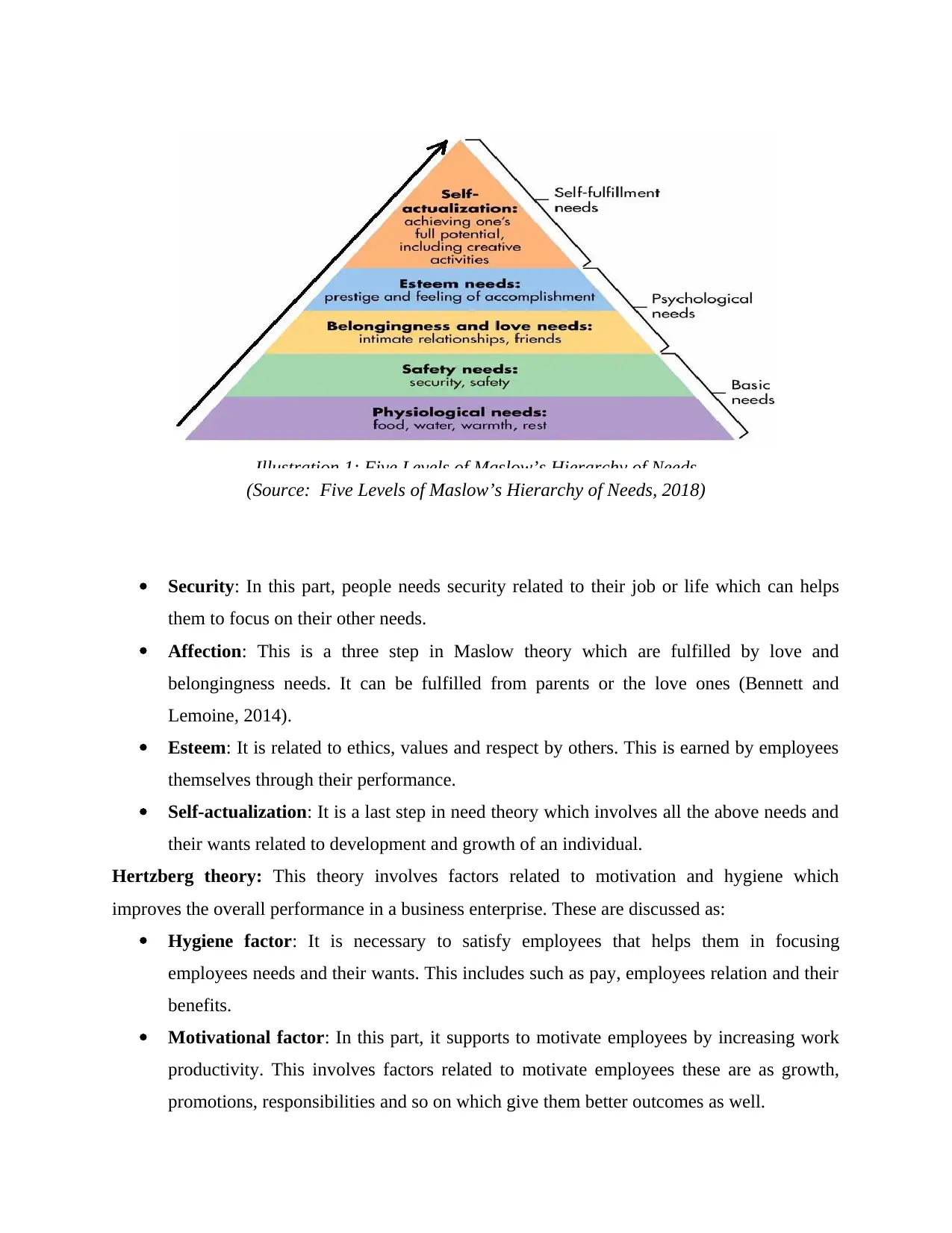
(Source: Five Levels of Maslow’s Hierarchy of Needs, 2018)
Security: In this part, people needs security related to their job or life which can helps
them to focus on their other needs.
Affection: This is a three step in Maslow theory which are fulfilled by love and
belongingness needs. It can be fulfilled from parents or the love ones (Bennett and
Lemoine, 2014).
Esteem: It is related to ethics, values and respect by others. This is earned by employees
themselves through their performance.
Self-actualization: It is a last step in need theory which involves all the above needs and
their wants related to development and growth of an individual.
Hertzberg theory: This theory involves factors related to motivation and hygiene which
improves the overall performance in a business enterprise. These are discussed as:
Hygiene factor: It is necessary to satisfy employees that helps them in focusing
employees needs and their wants. This includes such as pay, employees relation and their
benefits.
Motivational factor: In this part, it supports to motivate employees by increasing work
productivity. This involves factors related to motivate employees these are as growth,
promotions, responsibilities and so on which give them better outcomes as well.
Illustration 1: Five Levels of Maslow’s Hierarchy of Needs
Security: In this part, people needs security related to their job or life which can helps
them to focus on their other needs.
Affection: This is a three step in Maslow theory which are fulfilled by love and
belongingness needs. It can be fulfilled from parents or the love ones (Bennett and
Lemoine, 2014).
Esteem: It is related to ethics, values and respect by others. This is earned by employees
themselves through their performance.
Self-actualization: It is a last step in need theory which involves all the above needs and
their wants related to development and growth of an individual.
Hertzberg theory: This theory involves factors related to motivation and hygiene which
improves the overall performance in a business enterprise. These are discussed as:
Hygiene factor: It is necessary to satisfy employees that helps them in focusing
employees needs and their wants. This includes such as pay, employees relation and their
benefits.
Motivational factor: In this part, it supports to motivate employees by increasing work
productivity. This involves factors related to motivate employees these are as growth,
promotions, responsibilities and so on which give them better outcomes as well.
Illustration 1: Five Levels of Maslow’s Hierarchy of Needs
Paraphrase This Document
Need a fresh take? Get an instant paraphrase of this document with our AI Paraphraser
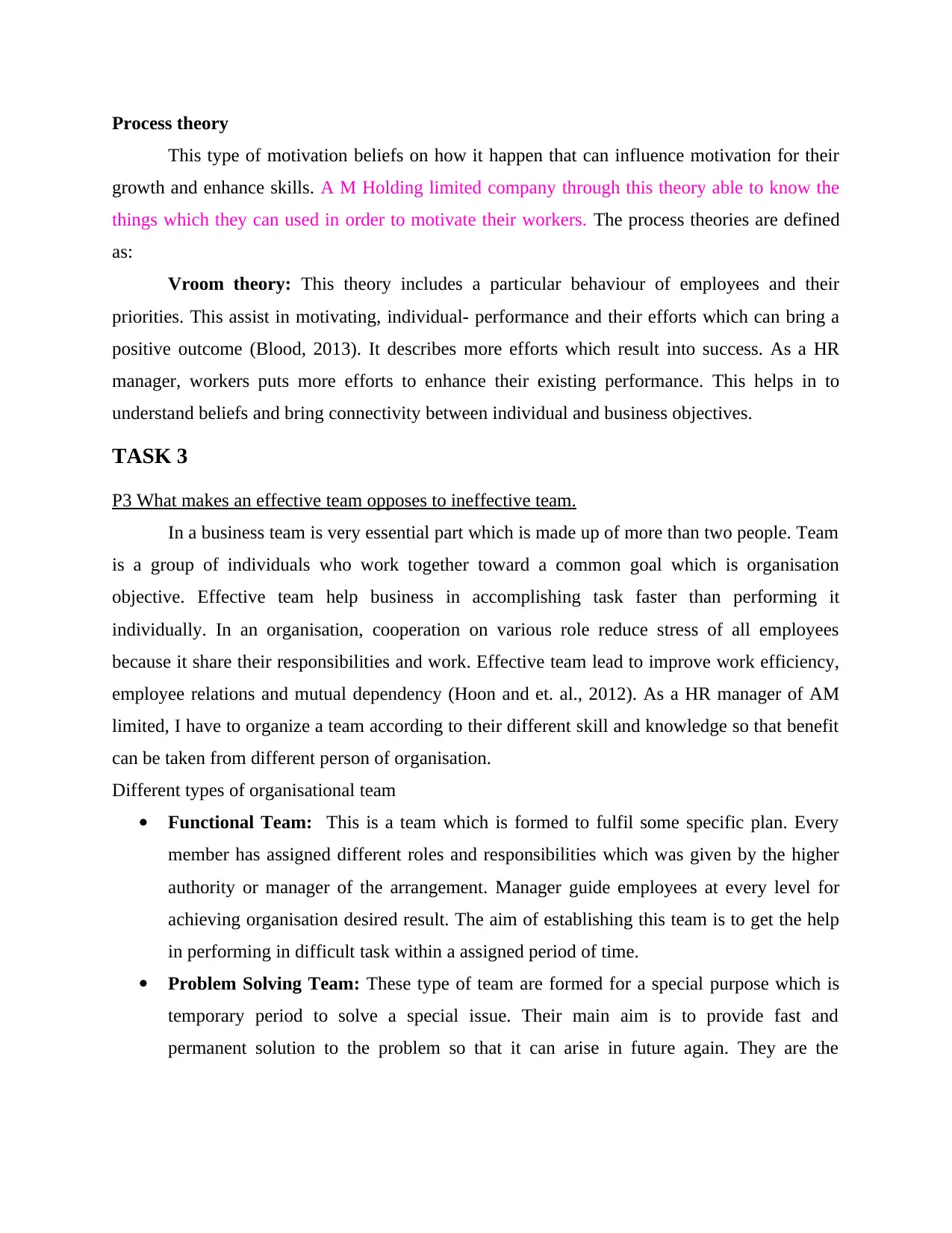
Process theory
This type of motivation beliefs on how it happen that can influence motivation for their
growth and enhance skills. A M Holding limited company through this theory able to know the
things which they can used in order to motivate their workers. The process theories are defined
as:
Vroom theory: This theory includes a particular behaviour of employees and their
priorities. This assist in motivating, individual- performance and their efforts which can bring a
positive outcome (Blood, 2013). It describes more efforts which result into success. As a HR
manager, workers puts more efforts to enhance their existing performance. This helps in to
understand beliefs and bring connectivity between individual and business objectives.
TASK 3
P3 What makes an effective team opposes to ineffective team.
In a business team is very essential part which is made up of more than two people. Team
is a group of individuals who work together toward a common goal which is organisation
objective. Effective team help business in accomplishing task faster than performing it
individually. In an organisation, cooperation on various role reduce stress of all employees
because it share their responsibilities and work. Effective team lead to improve work efficiency,
employee relations and mutual dependency (Hoon and et. al., 2012). As a HR manager of AM
limited, I have to organize a team according to their different skill and knowledge so that benefit
can be taken from different person of organisation.
Different types of organisational team
Functional Team: This is a team which is formed to fulfil some specific plan. Every
member has assigned different roles and responsibilities which was given by the higher
authority or manager of the arrangement. Manager guide employees at every level for
achieving organisation desired result. The aim of establishing this team is to get the help
in performing in difficult task within a assigned period of time.
Problem Solving Team: These type of team are formed for a special purpose which is
temporary period to solve a special issue. Their main aim is to provide fast and
permanent solution to the problem so that it can arise in future again. They are the
This type of motivation beliefs on how it happen that can influence motivation for their
growth and enhance skills. A M Holding limited company through this theory able to know the
things which they can used in order to motivate their workers. The process theories are defined
as:
Vroom theory: This theory includes a particular behaviour of employees and their
priorities. This assist in motivating, individual- performance and their efforts which can bring a
positive outcome (Blood, 2013). It describes more efforts which result into success. As a HR
manager, workers puts more efforts to enhance their existing performance. This helps in to
understand beliefs and bring connectivity between individual and business objectives.
TASK 3
P3 What makes an effective team opposes to ineffective team.
In a business team is very essential part which is made up of more than two people. Team
is a group of individuals who work together toward a common goal which is organisation
objective. Effective team help business in accomplishing task faster than performing it
individually. In an organisation, cooperation on various role reduce stress of all employees
because it share their responsibilities and work. Effective team lead to improve work efficiency,
employee relations and mutual dependency (Hoon and et. al., 2012). As a HR manager of AM
limited, I have to organize a team according to their different skill and knowledge so that benefit
can be taken from different person of organisation.
Different types of organisational team
Functional Team: This is a team which is formed to fulfil some specific plan. Every
member has assigned different roles and responsibilities which was given by the higher
authority or manager of the arrangement. Manager guide employees at every level for
achieving organisation desired result. The aim of establishing this team is to get the help
in performing in difficult task within a assigned period of time.
Problem Solving Team: These type of team are formed for a special purpose which is
temporary period to solve a special issue. Their main aim is to provide fast and
permanent solution to the problem so that it can arise in future again. They are the
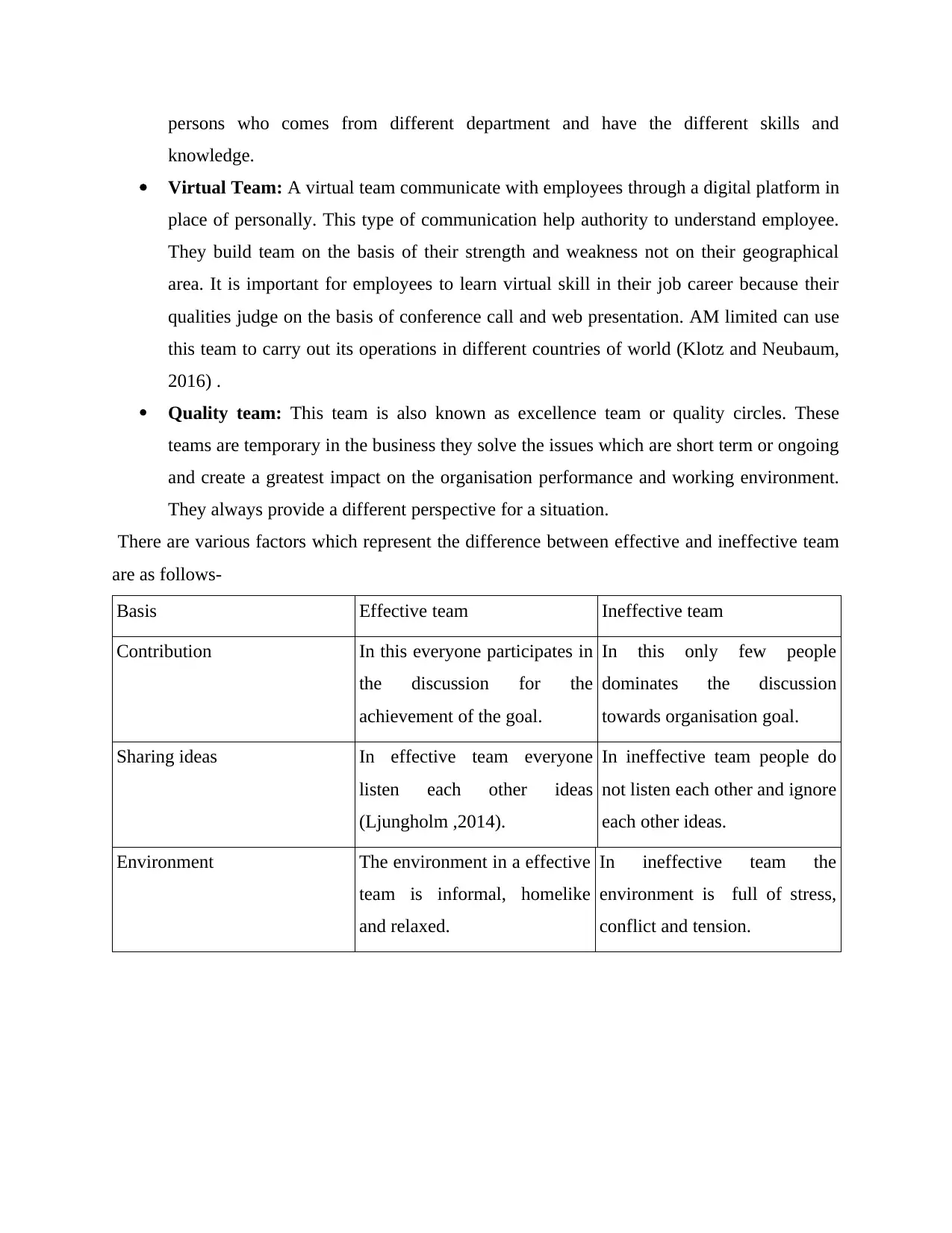
persons who comes from different department and have the different skills and
knowledge.
Virtual Team: A virtual team communicate with employees through a digital platform in
place of personally. This type of communication help authority to understand employee.
They build team on the basis of their strength and weakness not on their geographical
area. It is important for employees to learn virtual skill in their job career because their
qualities judge on the basis of conference call and web presentation. AM limited can use
this team to carry out its operations in different countries of world (Klotz and Neubaum,
2016) .
Quality team: This team is also known as excellence team or quality circles. These
teams are temporary in the business they solve the issues which are short term or ongoing
and create a greatest impact on the organisation performance and working environment.
They always provide a different perspective for a situation.
There are various factors which represent the difference between effective and ineffective team
are as follows-
Basis Effective team Ineffective team
Contribution In this everyone participates in
the discussion for the
achievement of the goal.
In this only few people
dominates the discussion
towards organisation goal.
Sharing ideas In effective team everyone
listen each other ideas
(Ljungholm ,2014).
In ineffective team people do
not listen each other and ignore
each other ideas.
Environment The environment in a effective
team is informal, homelike
and relaxed.
In ineffective team the
environment is full of stress,
conflict and tension.
knowledge.
Virtual Team: A virtual team communicate with employees through a digital platform in
place of personally. This type of communication help authority to understand employee.
They build team on the basis of their strength and weakness not on their geographical
area. It is important for employees to learn virtual skill in their job career because their
qualities judge on the basis of conference call and web presentation. AM limited can use
this team to carry out its operations in different countries of world (Klotz and Neubaum,
2016) .
Quality team: This team is also known as excellence team or quality circles. These
teams are temporary in the business they solve the issues which are short term or ongoing
and create a greatest impact on the organisation performance and working environment.
They always provide a different perspective for a situation.
There are various factors which represent the difference between effective and ineffective team
are as follows-
Basis Effective team Ineffective team
Contribution In this everyone participates in
the discussion for the
achievement of the goal.
In this only few people
dominates the discussion
towards organisation goal.
Sharing ideas In effective team everyone
listen each other ideas
(Ljungholm ,2014).
In ineffective team people do
not listen each other and ignore
each other ideas.
Environment The environment in a effective
team is informal, homelike
and relaxed.
In ineffective team the
environment is full of stress,
conflict and tension.
⊘ This is a preview!⊘
Do you want full access?
Subscribe today to unlock all pages.

Trusted by 1+ million students worldwide
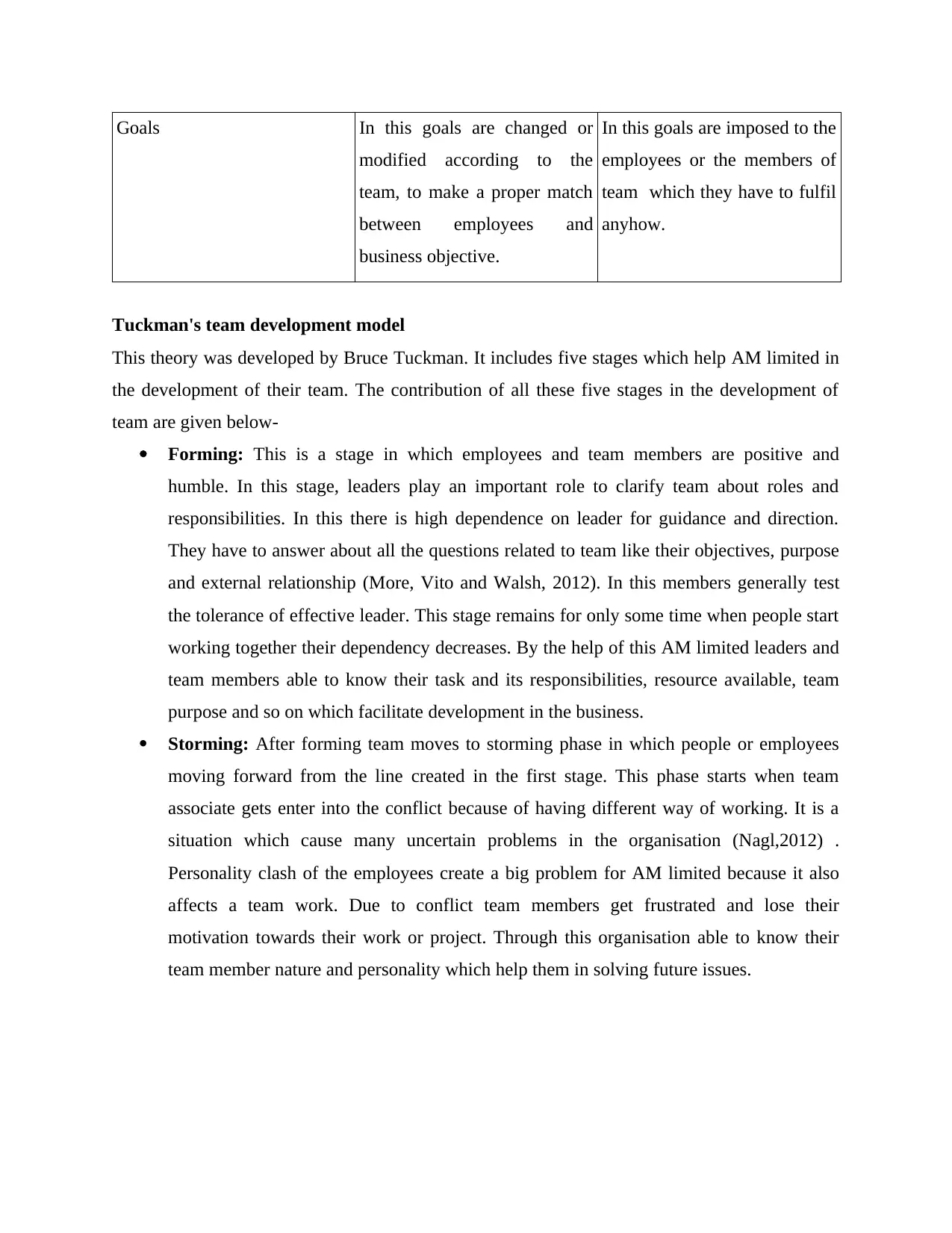
Goals In this goals are changed or
modified according to the
team, to make a proper match
between employees and
business objective.
In this goals are imposed to the
employees or the members of
team which they have to fulfil
anyhow.
Tuckman's team development model
This theory was developed by Bruce Tuckman. It includes five stages which help AM limited in
the development of their team. The contribution of all these five stages in the development of
team are given below-
Forming: This is a stage in which employees and team members are positive and
humble. In this stage, leaders play an important role to clarify team about roles and
responsibilities. In this there is high dependence on leader for guidance and direction.
They have to answer about all the questions related to team like their objectives, purpose
and external relationship (More, Vito and Walsh, 2012). In this members generally test
the tolerance of effective leader. This stage remains for only some time when people start
working together their dependency decreases. By the help of this AM limited leaders and
team members able to know their task and its responsibilities, resource available, team
purpose and so on which facilitate development in the business.
Storming: After forming team moves to storming phase in which people or employees
moving forward from the line created in the first stage. This phase starts when team
associate gets enter into the conflict because of having different way of working. It is a
situation which cause many uncertain problems in the organisation (Nagl,2012) .
Personality clash of the employees create a big problem for AM limited because it also
affects a team work. Due to conflict team members get frustrated and lose their
motivation towards their work or project. Through this organisation able to know their
team member nature and personality which help them in solving future issues.
modified according to the
team, to make a proper match
between employees and
business objective.
In this goals are imposed to the
employees or the members of
team which they have to fulfil
anyhow.
Tuckman's team development model
This theory was developed by Bruce Tuckman. It includes five stages which help AM limited in
the development of their team. The contribution of all these five stages in the development of
team are given below-
Forming: This is a stage in which employees and team members are positive and
humble. In this stage, leaders play an important role to clarify team about roles and
responsibilities. In this there is high dependence on leader for guidance and direction.
They have to answer about all the questions related to team like their objectives, purpose
and external relationship (More, Vito and Walsh, 2012). In this members generally test
the tolerance of effective leader. This stage remains for only some time when people start
working together their dependency decreases. By the help of this AM limited leaders and
team members able to know their task and its responsibilities, resource available, team
purpose and so on which facilitate development in the business.
Storming: After forming team moves to storming phase in which people or employees
moving forward from the line created in the first stage. This phase starts when team
associate gets enter into the conflict because of having different way of working. It is a
situation which cause many uncertain problems in the organisation (Nagl,2012) .
Personality clash of the employees create a big problem for AM limited because it also
affects a team work. Due to conflict team members get frustrated and lose their
motivation towards their work or project. Through this organisation able to know their
team member nature and personality which help them in solving future issues.
Paraphrase This Document
Need a fresh take? Get an instant paraphrase of this document with our AI Paraphraser
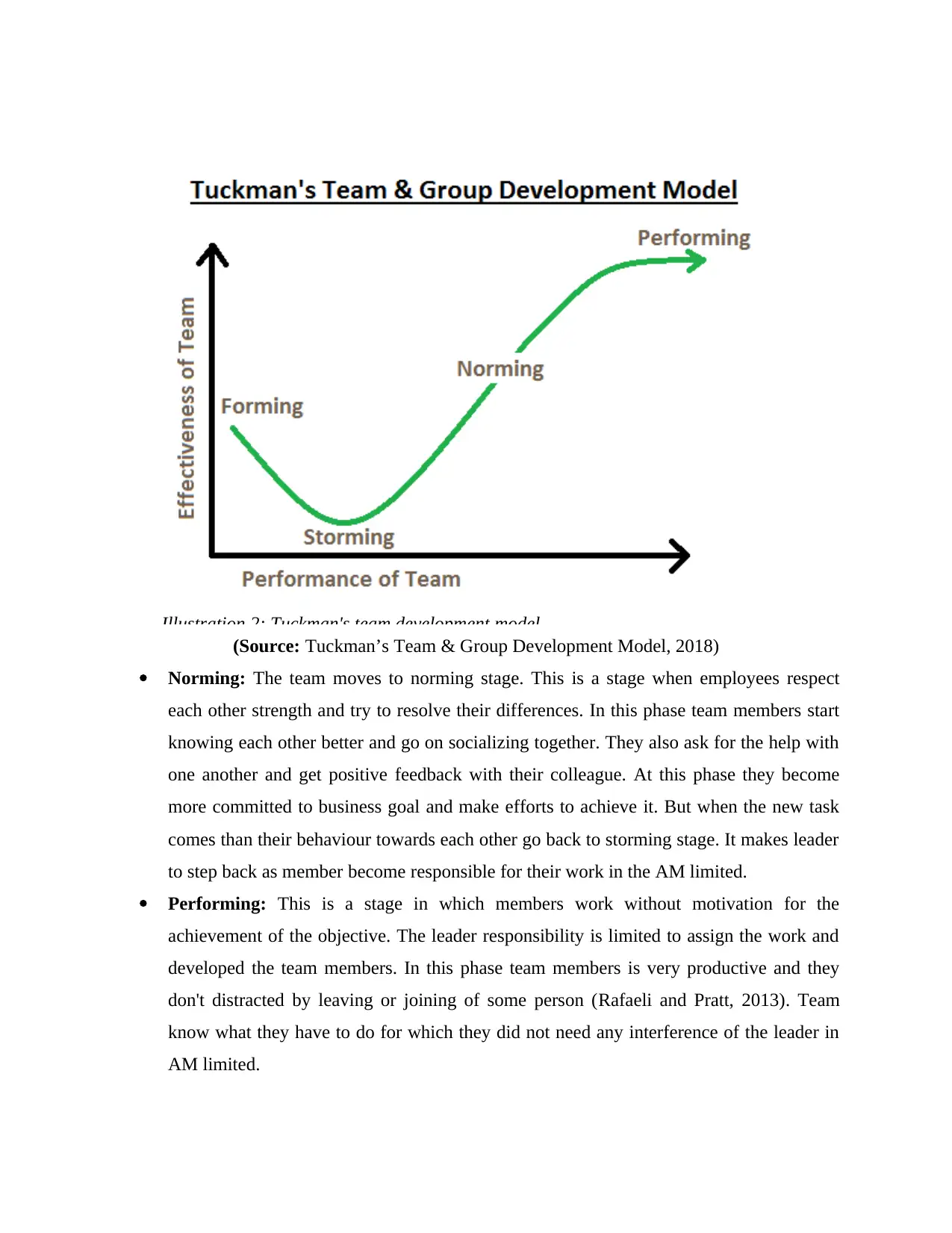
(Source: Tuckman’s Team & Group Development Model, 2018)
Norming: The team moves to norming stage. This is a stage when employees respect
each other strength and try to resolve their differences. In this phase team members start
knowing each other better and go on socializing together. They also ask for the help with
one another and get positive feedback with their colleague. At this phase they become
more committed to business goal and make efforts to achieve it. But when the new task
comes than their behaviour towards each other go back to storming stage. It makes leader
to step back as member become responsible for their work in the AM limited.
Performing: This is a stage in which members work without motivation for the
achievement of the objective. The leader responsibility is limited to assign the work and
developed the team members. In this phase team members is very productive and they
don't distracted by leaving or joining of some person (Rafaeli and Pratt, 2013). Team
know what they have to do for which they did not need any interference of the leader in
AM limited.
Illustration 2: Tuckman's team development model
Norming: The team moves to norming stage. This is a stage when employees respect
each other strength and try to resolve their differences. In this phase team members start
knowing each other better and go on socializing together. They also ask for the help with
one another and get positive feedback with their colleague. At this phase they become
more committed to business goal and make efforts to achieve it. But when the new task
comes than their behaviour towards each other go back to storming stage. It makes leader
to step back as member become responsible for their work in the AM limited.
Performing: This is a stage in which members work without motivation for the
achievement of the objective. The leader responsibility is limited to assign the work and
developed the team members. In this phase team members is very productive and they
don't distracted by leaving or joining of some person (Rafaeli and Pratt, 2013). Team
know what they have to do for which they did not need any interference of the leader in
AM limited.
Illustration 2: Tuckman's team development model
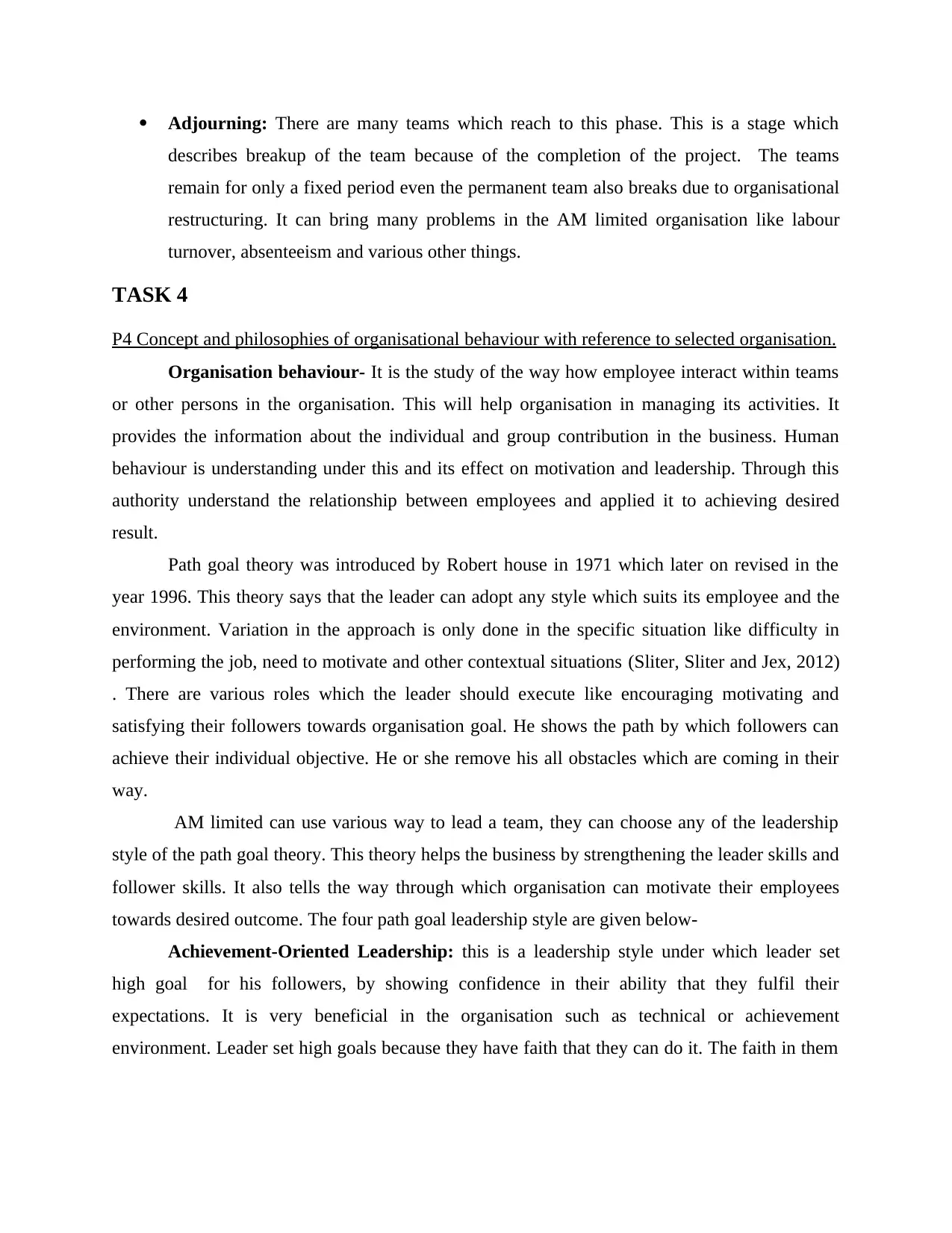
Adjourning: There are many teams which reach to this phase. This is a stage which
describes breakup of the team because of the completion of the project. The teams
remain for only a fixed period even the permanent team also breaks due to organisational
restructuring. It can bring many problems in the AM limited organisation like labour
turnover, absenteeism and various other things.
TASK 4
P4 Concept and philosophies of organisational behaviour with reference to selected organisation.
Organisation behaviour- It is the study of the way how employee interact within teams
or other persons in the organisation. This will help organisation in managing its activities. It
provides the information about the individual and group contribution in the business. Human
behaviour is understanding under this and its effect on motivation and leadership. Through this
authority understand the relationship between employees and applied it to achieving desired
result.
Path goal theory was introduced by Robert house in 1971 which later on revised in the
year 1996. This theory says that the leader can adopt any style which suits its employee and the
environment. Variation in the approach is only done in the specific situation like difficulty in
performing the job, need to motivate and other contextual situations (Sliter, Sliter and Jex, 2012)
. There are various roles which the leader should execute like encouraging motivating and
satisfying their followers towards organisation goal. He shows the path by which followers can
achieve their individual objective. He or she remove his all obstacles which are coming in their
way.
AM limited can use various way to lead a team, they can choose any of the leadership
style of the path goal theory. This theory helps the business by strengthening the leader skills and
follower skills. It also tells the way through which organisation can motivate their employees
towards desired outcome. The four path goal leadership style are given below-
Achievement-Oriented Leadership: this is a leadership style under which leader set
high goal for his followers, by showing confidence in their ability that they fulfil their
expectations. It is very beneficial in the organisation such as technical or achievement
environment. Leader set high goals because they have faith that they can do it. The faith in them
describes breakup of the team because of the completion of the project. The teams
remain for only a fixed period even the permanent team also breaks due to organisational
restructuring. It can bring many problems in the AM limited organisation like labour
turnover, absenteeism and various other things.
TASK 4
P4 Concept and philosophies of organisational behaviour with reference to selected organisation.
Organisation behaviour- It is the study of the way how employee interact within teams
or other persons in the organisation. This will help organisation in managing its activities. It
provides the information about the individual and group contribution in the business. Human
behaviour is understanding under this and its effect on motivation and leadership. Through this
authority understand the relationship between employees and applied it to achieving desired
result.
Path goal theory was introduced by Robert house in 1971 which later on revised in the
year 1996. This theory says that the leader can adopt any style which suits its employee and the
environment. Variation in the approach is only done in the specific situation like difficulty in
performing the job, need to motivate and other contextual situations (Sliter, Sliter and Jex, 2012)
. There are various roles which the leader should execute like encouraging motivating and
satisfying their followers towards organisation goal. He shows the path by which followers can
achieve their individual objective. He or she remove his all obstacles which are coming in their
way.
AM limited can use various way to lead a team, they can choose any of the leadership
style of the path goal theory. This theory helps the business by strengthening the leader skills and
follower skills. It also tells the way through which organisation can motivate their employees
towards desired outcome. The four path goal leadership style are given below-
Achievement-Oriented Leadership: this is a leadership style under which leader set
high goal for his followers, by showing confidence in their ability that they fulfil their
expectations. It is very beneficial in the organisation such as technical or achievement
environment. Leader set high goals because they have faith that they can do it. The faith in them
⊘ This is a preview!⊘
Do you want full access?
Subscribe today to unlock all pages.

Trusted by 1+ million students worldwide
1 out of 20
Related Documents
Your All-in-One AI-Powered Toolkit for Academic Success.
+13062052269
info@desklib.com
Available 24*7 on WhatsApp / Email
![[object Object]](/_next/static/media/star-bottom.7253800d.svg)
Unlock your academic potential
Copyright © 2020–2025 A2Z Services. All Rights Reserved. Developed and managed by ZUCOL.





